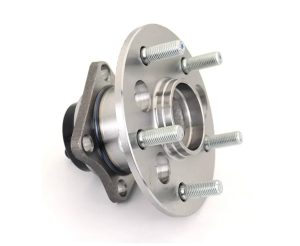Wheel hubs and bearings are critical parts of your vehicle’s drivetrain and suspension system. They allow your wheels to spin freely, support the car’s weight, and ensure smooth steering and handling. Yet, many drivers don’t realize how much their driving style and habits can accelerate hub and bearing wear. Over time, aggressive driving, poor road choices, load management, and neglect can shorten bearing life significantly.
In this article, we’ll examine the driving behaviors that most stress wheel hubs and bearings, how to spot early signs of wear, and best practices to prolong their life. And if you need replacements, you can Buy Wheel Hub & Bearings online from reliable sources.
Driving Behaviors That Accelerate Hub & Bearing Wear

Here are the most common habits and conditions that put undue stress on your hub and bearings:
Sudden Acceleration and Hard Braking
Frequent hard launches or abrupt stops create impact loads inside the bearing. The rolling elements (balls, rollers) jump or slam against raceways, causing micro-pitting or surface damage.
Sustained High-Speed Driving
Running continuously at high speeds increases bearing temperature. Grease oxidation, lubricant breakdown, and reduced viscosity accelerate internal wear.
Driving Through Water, Mud, or Puddles
Water invasion can emulsify lubricants, wash them out, or degrade seals. Moisture also promotes corrosion within the bearing.
Aggressive Cornering, Lane Changes, or Frequent Turning
Sharp turns load one side of a bearing heavily, causing uneven load distribution and localized fatigue on raceways.
Rough Terrain, Potholes, and Road Impacts
Hit bumps, potholes, curbs, or rough roads frequently — each jolt can shock the bearing and the hub. Over time, repeated impact weakens cages, races, or mounting surfaces.
Overloading the Vehicle
Carrying heavy loads or towing increases the net radial load on bearings, pushing them beyond ideal operating range. Many OEM bearings are rated for standard loads; exceeding them reduces margin.
Early Warning Signs You Might Be Causing Wear
Recognizing symptoms early gives you a chance to intervene. Here are signs your driving style might already be hurting your bearings:
| Symptom | Likely Cause | What to Check |
|---|---|---|
| Low humming, grinding, or droning noise | Bearing wear or lubrication loss | Spin wheel at various speeds and listen |
| Vibration or shimmy in steering wheel | Hub looseness or bearing play | Check wheel play when lifted |
| Wheel wobble | Excess bearing play or looseness | Rock wheel side-to-side or front-to-back |
| ABS warning light | Hub sensor interference from wear | Inspect hub & ABS ring assembly |
| Uneven tire wear | Misaligned hub or bearing irregularities | Inspect tread and alignment |
| Higher temperature at hub | Friction, lubricant failure, or overload | After drive, feel hub heat (cautiously) |
How Much Can Driving Habits Shorten Life?
Under ideal conditions, many hub bearings can last 80,000 to 150,000 km. But in aggressive or harsh conditions, the effective lifespan might drop by 30–50% or more. If your driving involves frequent stops, rough roads, or lots of water crossings, expect to inspect and possibly replace bearings more often.
Best Practices to Minimize Bearing Wear
Here are actionable tips to extend the life of hubs and bearings — many influenced by your driving habits:
Drive Smoothly
-
Avoid sudden acceleration or braking.
-
Anticipate traffic to reduce stops.
-
Modulate throttle and apply brakes gently.
Moderate Speed on Long Trips
-
On highways, avoid pushing max speed continuously.
-
Incorporate speed breaks or occasional cooling.
-
Allow bearings to dissipate heat on longer drives.
Avoid Deep Water & Mud
-
Skirt heavy puddles or crossings when possible.
-
If immersion is unavoidable, inspect and re-lubricate hub seals afterwards.
Take Turns & Lane Changes Gently
-
Don’t yank the wheel aggressively.
-
Smooth steering transitions reduce peak loads.
Avoid Potholes & Rough Roads
-
Slow down for bumps when possible.
-
Maintain safe distance to see road imperfections ahead.
Manage Load & Maintenance
-
Don’t exceed your vehicle’s payload rating.
-
Distribute weight evenly.
-
Inspect hubs and bearings more frequently under heavy load usage.
Regular Inspections & Early Intervention
-
Check for wheel play during service intervals.
-
Monitor wheel noise, hub temperature, alignment, and tire wear.
-
Replace worn seals before they allow contamination.
Use Quality Parts & Assembly Practices
-
Use correct torque specs and tools during installation.
-
Ensure proper lubrication and sealing.
-
Replace in matched pairs to maintain balance.
Summary and Takeaway

Driving habits have a direct and cumulative impact on how long your wheel hubs and bearings last. Aggressive behavior — hard braking, high-speed runs, frequent turns, and water crossings — accelerates wear. But by adopting smoother, more considered driving, moderating speed, managing loads, and keeping a regular inspection schedule, you can greatly prolong their service life.
If signs of bearing wear appear — noise, vibration, ABS issues, wobble — don’t delay. Replace compromised components with reliable parts, and you can Buy Wheel Hub & Bearings online from trusted suppliers to restore safe and smooth performance.
Let me know if you want a version targeted at a specific vehicle type (SUVs, trucks, EVs) or a shorter summary for a blog post.